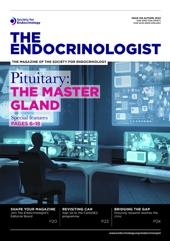Pituitary tumours are one of the most common types of intracranial tumour and account for up to 22.5% of all cases.1 Artificial intelligence (AI) represents one of the most powerful tools in the modern neurosurgeon’s arsenal in tackling these tumours. It constitutes a true paradigm shift in the way patients with pituitary tumours can be managed, not just on the operating table, but through the entirety of their journey.
PREOPERATIVE ISSUES
Diagnosing pituitary adenomas presents a perplexing challenge, due to the tumours’ non-specific and subtle presentations. A single physician may not join the dots, and diagnostic delay – which can often be for many years – results in a tumour that is larger and harder to resect safely. The spread of tumours to critical areas, such as the cavernous sinus, represents a crucial factor affecting surgical outcomes, and even the most skilled neurosurgeon and their team may struggle to excise a tumour that could have been easily managed years earlier.
‘Using AI to analyse thousands of cases could offer each surgeon decision support when required, and make suggestions based on past similar surgeries, or guide a surgeon in unknown territory.’
The wealth of patient data contained within medical records has the potential to unlock diagnostic solutions. However, the sheer volume of information generated from a single hospital visit overwhelms the capacity of a single clinician to process it swiftly. Enter large language models (LLMs), an exciting family of machine learning models that have been trained on vast amounts of textual data. Equipped with natural language processing capabilities, these AI models can swiftly analyse text, answer queries and categorise data, as well as perform their own variant of clinical reasoning.2 Harnessing the power of LLMs enables medical teams to swiftly comb through a patient’s complete medical history.3
Generative AI models can be used to raise suspicion of disease even in cases where patients are admitted under entirely different services. Weighting predictions based on health records, including blood tests and results of other investigations, may therefore allow clinicians to make the diagnosis of pituitary tumours years in advance of when they otherwise would, therefore reducing the tumour burden and improving the likelihood of successful management.4 This concept has already been demonstrated in other conditions affecting the brain, such as normal pressure hydrocephalus.5
OPERATIVE CONSIDERATIONS
Intraoperative neurosurgical decisions are often highly complex and made under pressure, which can lead to significant variation in practice. Data gathered both from the live surgical video and from devices worn and wielded by members of the operating team6 may allow the operating room of the future to ‘orchestrate team members to a common workflow’.7 AI systems are already able to monitor the surgical field to detect different steps of each operation, watching for changes in instruments, the relevant anatomy, and the actions taken.8 In the first instance, this can drive efficiency by tracking progress during surgery and alerting team members during critical moments, automatically writing operative notes, and indexing cases for future teaching.
Most excitingly, this form of workflow analysis can also be used to explore the variations in operative practice, comparing the corresponding outcomes, and using this analysis to inform decision making in future cases. Using AI to analyse thousands of cases from international centres could offer each surgeon decision support when required, using the latest large scale databases, and make suggestions based on past similar surgeries, or guide a surgeon in unknown territory.
POSTOPERATIVE FACTORS
'AI is as much Pandora’s box as panacea. The applications of large scale, big data analysis and autonomous learning are countless – but clinicians have a responsibility to their patients to use these tools carefully and responsibly.'
Of course, resection is only part of the challenge. The patient must be monitored closely during their inpatient postoperative phase, and only sent home when it is safe to do so. Predicting short term patient outcomes after pituitary surgery is well known to be very difficult, with common complications including hypopituitarism, dysnatraemia and cerebrospinal fluid rhinorrhoea.9 Neural networks might be useful in stratifying patients into high and low risk groups through analysis of preoperative, operative and postoperative datasets, allowing some patients to be discharged early through rapid recovery protocols,10 and others to be kept longer for closer monitoring.
Moreover, on discharge, tumours that appear identical in pathology and postoperative imaging can exhibit vastly different behaviours in the long term, with some far more at risk of recurrence and the need for additional interventions, whether surgical or otherwise. A patient’s journey represents a rich, multimodal and longitudinal dataset characterised by complex and non-linear relationships between variables. This intricacy provides a prime opportunity for AI solutions to piece together the puzzle and aid in expediting patients’ discharge from hospital.
CONCLUSION
To close, AI is as much Pandora’s box as panacea. The applications of large scale, big data analysis and autonomous learning are countless – but clinicians have a responsibility to their patients to use these tools carefully and responsibly. The future of pituitary surgery lies in the harmonious synergy between the surgeon and AI, transcending the limitations of each individual component, and neurosurgeons have a duty to embrace this paradigm shift for the betterment of both their craft and their patients.
OLIVER E BURTON, DANYAL Z KHAM AND HANI J MARCUS
Department of Neurosurgery, National Hospital for Neurology and Neurosurgery, London, and Wellcome/EPSRC Centre for Interventional and Surgical Sciences, University College London
REFERENCES
- Ezzat S et al. 2004 Cancer 101 613–619.
- Moor M et al. 2023 Nature 616 259–265.
- Noor K et al. 2022 JMIR Medical Informatics 10 e38122.
- Kraljevic Z et al. 2023 arXiv doi: 10.48550/arXiv.2212.08072.
- Sotoudeh H et al. 2021 Cureus 13 e18497.
- Layard Horsfall H et al. 2023 Neurosurgery 92 639–646.
- Khan DZ et al. 2023 Endocrine Reviews doi: 10.1210/endrev/bnad014.
- Khan DZ et al. 2021 Brain & Spine 1 100580.
- CRANIAL Consortium 2021 World Neurosurgery 149 e1077–e1089.
- Lobatto DJ et al. 2020 Endocrine 69 175–187.





